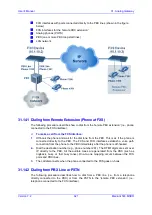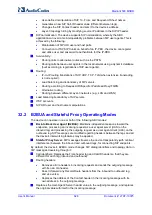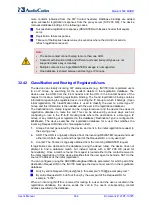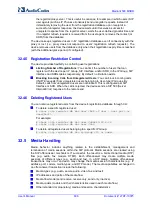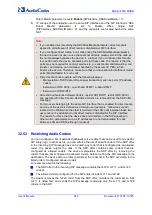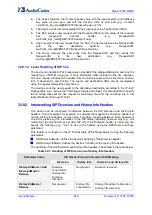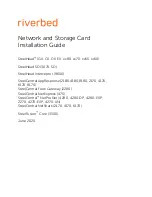
User's Manual
632
Document #: LTRT-10375
Mediant 500 MSBR
♦
Source URL: Obtained from the From header. If the From header contains
the value 'Anonymous', the source URL is obtained from the P-Preferred-
Identity header. If the P-Preferred-Identity header does not exist, the source
URL is obtained from the P-Asserted-Identity header.
♦
Destination URL: Obtained from the Request-URI.
•
REGISTER dialogs:
♦
Source URL: Obtained from the To header.
♦
Destination URL: Obtained from the Request-URI.
Note:
You can specify the SIP header from where you want the device to obtain the
source URL in the incoming dialog request. This is configured in the IP Groups table
using the 'Source URI Input' parameter (see Configuring IP Groups on page 333).
2.
Determining SIP Interface:
The device checks the SIP Interface on which the SIP
dialog is received. The SIP Interface defines the local SIP "listening" port and IP
network interface. For more information, see Configuring SIP Interfaces on page 325.
3.
Applying SIP Message Manipulation:
Depending on configuration, the device can
apply a SIP message manipulation rule (assigned to the SIP Interface) on the
incoming SIP message. A SIP Message Manipulation rule defines a matching
characteristics (
condition
) of the incoming SIP message and the corresponding
manipulation operation (e.g., remove the P-Asserted-Identity header), which can apply
to almost any aspect of the message (add, remove or modify SIP headers and
parameters). For more information, see Configuring SIP Message Manipulation on
page 381.
4.
Classifying to an IP Group:
Classification identifies the incoming SIP dialog request
as belonging to a specific IP Group (i.e., from where the SIP dialog request
originated). The classification process is based on the SRD to which the dialog
belongs (the SRD is determined according to the SIP Interface). For more information,
see Configuring Classification Rules on page 663.
5.
Applying Inbound Manipulation:
Depending on configuration, the device can apply
an Inbound Manipulation rule to the incoming dialog. This manipulates the user part of
the SIP URI for source (e.g., in the SIP From header) and destination (e.g., in the
Request-URI line). The manipulation rule is associated with the incoming dialog, by
configuring the rule with incoming matching characteristics such as source IP Group
and destination host name. The manipulation rules are also assigned a Routing
Policy, which in turn, is assigned to IP-to-IP routing rules. As most deployments
require only one Routing Policy, the default Routing Policy is automatically assigned to
manipulation and routing rules. For more information, see Configuring IP-to-IP
Inbound Manipulations on page 701.
6.
SBC IP-to-IP Routing:
The device searches the IP-to-IP Routing table for a routing
rule that matches the characteristics of the incoming call. If found, the device routes
the call to the configured destination which can be, for example, an IP Group, the
Request-URI if the user is registered with the device, and a specified IP address. For
more information, see Configuring SBC IP-to-IP Routing Rules on page 671.
7.
Applying Inbound SIP Message Manipulation:
Depending on configuration, the
device can apply a SIP message manipulation rule (assigned to the IP Group) on the
incoming dialog. For more information, see Stage 3.
8.
Applying Outbound Manipulation:
Depending on configuration, the device can
apply an Outbound Manipulation rule to the outbound dialog. This manipulates the
user part of the Request-URI for source (e.g., in the SIP From header) or destination
(e.g., in the SIP To header) or calling name in the outbound SIP dialog. The
manipulation rule is associated with the dialog, by configuring the rule with incoming
matching characteristics such as source IP Group and destination host name. The
Summary of Contents for Mediant 500 MSBR
Page 2: ......
Page 33: ...Part I Getting Started with Initial Connectivity ...
Page 34: ......
Page 36: ...User s Manual 36 Document LTRT 10375 Mediant 500 MSBR This page is intentionally left blank ...
Page 40: ...User s Manual 40 Document LTRT 10375 Mediant 500 MSBR This page is intentionally left blank ...
Page 45: ...Part II Management Tools ...
Page 46: ......
Page 48: ...User s Manual 48 Document LTRT 10375 Mediant 500 MSBR This page is intentionally left blank ...
Page 115: ...Part III General System Settings ...
Page 116: ......
Page 132: ...User s Manual 132 Document LTRT 10375 Mediant 500 MSBR This page is intentionally left blank ...
Page 137: ...Part IV General VoIP Configuration ...
Page 138: ......
Page 290: ...User s Manual 290 Document LTRT 10375 Mediant 500 MSBR This page is intentionally left blank ...
Page 306: ...User s Manual 306 Document LTRT 10375 Mediant 500 MSBR This page is intentionally left blank ...
Page 380: ...User s Manual 380 Document LTRT 10375 Mediant 500 MSBR This page is intentionally left blank ...
Page 454: ...User s Manual 454 Document LTRT 10375 Mediant 500 MSBR This page is intentionallty left blank ...
Page 455: ...Part V Gateway Application ...
Page 456: ......
Page 460: ...User s Manual 460 Document LTRT 10375 Mediant 500 MSBR This page is intentionally left blank ...
Page 484: ...User s Manual 484 Document LTRT 10375 Mediant 500 MSBR This page is intentionally left blank ...
Page 494: ...User s Manual 494 Document LTRT 10375 Mediant 500 MSBR This page is intentionally left blank ...
Page 625: ...Part VI Session Border Controller Application ...
Page 626: ......
Page 654: ...User s Manual 654 Document LTRT 10375 Mediant 500 MSBR This page is intentionally left blank ...
Page 656: ...User s Manual 656 Document LTRT 10375 Mediant 500 MSBR This page is intentionally left blank ...
Page 741: ...Part VII Cloud Resilience Package ...
Page 742: ......
Page 751: ...Part VIII Data Router Configuration ...
Page 752: ......
Page 753: ......
Page 754: ......
Page 756: ...User s Manual 756 Document LTRT 10375 Mediant 500 MSBR This page is intentionally left blank ...
Page 757: ...Part IX Maintenance ...
Page 758: ......
Page 834: ...User s Manual 834 Document LTRT 10375 Mediant 500 MSBR This page is intetnionaly left blank ...
Page 837: ...Part X Status Performance Monitoring and Reporting ...
Page 838: ......
Page 848: ...User s Manual 848 Document LTRT 10375 Mediant 500 MSBR This page is intentionally left blank ...
Page 852: ...User s Manual 852 Document LTRT 10375 Mediant 500 MSBR This page is intentionally left blank ...
Page 854: ...User s Manual 854 Document LTRT 10375 Mediant 500 MSBR This page is intentionally left blank ...
Page 878: ...User s Manual 878 Document LTRT 10375 Mediant 500 MSBR This page is intentionally left blank ...
Page 880: ...User s Manual 880 Document LTRT 10375 Mediant 500 MSBR This page is intentionally left blank ...
Page 926: ...User s Manual 926 Document LTRT 10375 Mediant 500 MSBR This page is intentionally left blank ...
Page 927: ...Part XI Diagnostics ...
Page 928: ......
Page 950: ...User s Manual 950 Document LTRT 10375 Mediant 500 MSBR This page is intentionally left blank ...
Page 954: ...User s Manual 954 Document LTRT 10375 Mediant 500 MSBR This page is intentionally left blank ...
Page 956: ...User s Manual 956 Document LTRT 10375 Mediant 500 MSBR This page is intentionally left blank ...
Page 958: ...User s Manual 958 Document LTRT 10375 Mediant 500 MSBR This page is intentionally left blank ...
Page 974: ...User s Manual 974 Document LTRT 10375 Mediant 500 MSBR This page is intentionally left blank ...
Page 976: ...User s Manual 976 Document LTRT 10375 Mediant 500 MSBR This page is intentionally left blank ...
Page 977: ...Part XII Appendix ...
Page 978: ......
Page 982: ...User s Manual 982 Document LTRT 10375 Mediant 500 MSBR This page is intentionally left blank ...




